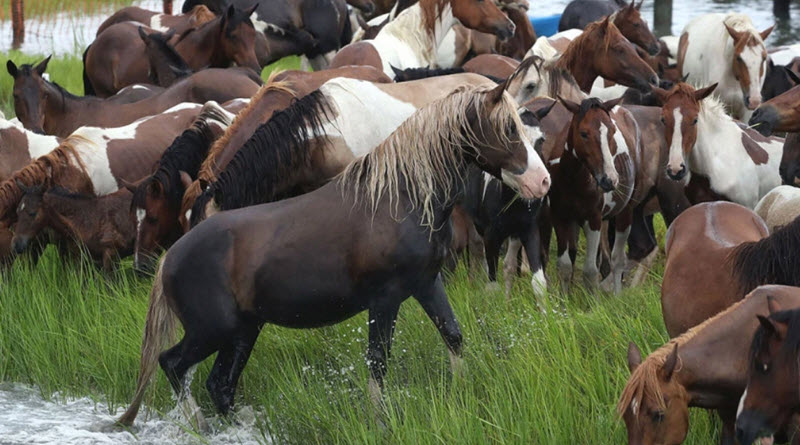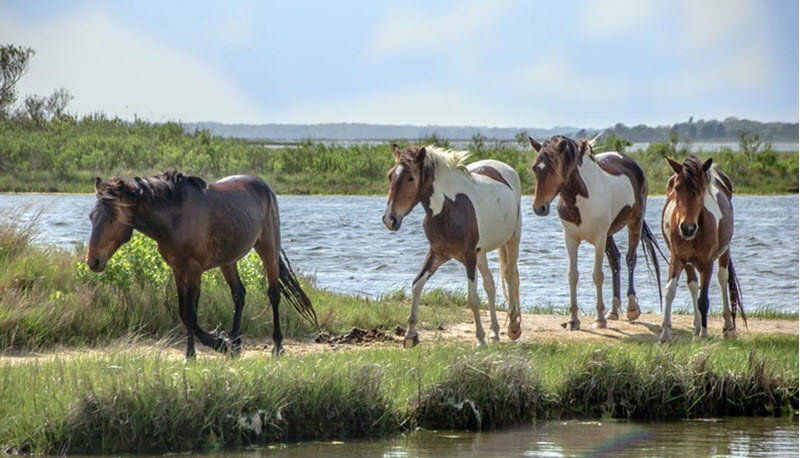Contents
The Assateague horse and the Chincoteague pony are two different names for essentially the same breed, one that developed in feral conditions on Assateague Island in the United States. This island is divided between the two states Maryland and Virginia. The individuals living on the Maryland side of the island are called Assateague horses, while the ones living on Virginia´s side are known as Chincoteague ponies. A fence separates the two herds from each other.
The whole island is owned by the federal U.S. government.

The Maryland side
The Assateague horses in Maryland live within the Assateague Island National Seashore, which is a part of the National Park Service system of the U.S. Department of the Interior.
The National Park Service´s policy is to treat the Assateague horses almost as if they were wild animals, although they are given contraceptives to prevent the herd from becoming too large.
The Virginia side
The Chincoteague ponies are owned by the Chincoteague Volunteer Fire Company and live in the Chincoteague National Wildlife Refuge.
The refuge is operated by the U.S. Fish & Wildlife Service and their policy is to have a veterinarian inspect the Chincoteague ponies twice a year.
Once a year, an auction is held where you can purchase large Chincoteague foals. The auction helps fund the fire company. Some buyers see the auction only as a way for them to donate money to the firefighters, and these buyers make their purchased foals to go back and live with the herd afterwards. Other buyers actually want to raise and keep a Chincoteague pony, so they take their foals home with them after the auction.
Off the island
Roughly a thousand Chincoteague ponies live away from the island. Export outside the United States is rare, with the exception of Canada.
When a Chincoteague pony is removed from the island as a foal and raised in non-feral conditions, it usually turns into a good companion that is obedient and quick to learn, and likes being handled by and cared for by humans. Chincoteague ponies are chiefly used for trail riding, hunting and driving.
Since they hail from individuals that could survive and have offspring in the harsh conditions of the island, Chincoteague ponies tend to be robust and of good health. They are easy keepers, so one needs to be careful not to overfeed them. Remember, their ancestors survived largely on salt marsh plants and brush.
Horse or pony?
Prior to the 20th century, the feral equines on Assateague Island were quite small – definitely small enough to be called ponies. In the 20th century, a substantial amount of horse (not pony) DNA was introduced to the population in a deliberate effort to make them higher. Since then, they are a bit higher than before and also more likely to display other horse features. Still, many of them are below 14.2 hands – the generally accepted cut off between horse and pony.
When individuals from the Virginia side of the island exceed 14.2 hands in height, they are still called Chincoteague ponies, not Chincoteague horses.

What does Chincoteague ponies look like?
How big is a Chincoteague pony?
The Chincoteague ponies that live in feral conditions average 13.2 hands. Individuals that grow up in non-feral conditions tend to become bigger, and some of them even exceed 14.2 hands.
Chincoteague ponies typically weigh around 850 lbs, but there are of course individual variations.
Colours
This is a breed with a high degree of genetic diversity when it comes to colours. All solid colours are found in the breed, and some individuals display pinto patterns.
(Trivia: The pinto pattern individuals tend to cost more at auction.)
Head
The head is straight or just slightly concave, with a broad forehead. Both throatlatch and neck are refined.
Body
- Well-angled shoulders.
- Broad chest with well-sprung ribs.
- Short back.
- Broad loins.
- Rounded croup.
- Thick and low-set tail.
- Sound and sturdy legs, with dense bone. Most individuals have straight legs.
Associations
There are two associations for Chincoteague ponies; both of them created in the latter half of the 20th century. Founded in 1985, The National Chincoteague Pony Association is the elder one, and its breed registry and studbook is open to Chincoteagu ponies born on or off the island. The Chincoteague Pony Association was founded in 1994 as an association open only to individuals born on the island and purchased at the early auction. (Many Chincoteague ponies born on the island are registered with both associations.)
History of the Chincoteague ponies
How did they come to the island?
We don´t know how or when the ponies first came to the island or why they became feral. European colonists who were present on the island in the mid-to-late 17th century did not mention anything about feral ponies or horses living there.
What we do know for certain, however, is that in the 17th century, livestock kept on the mainland was taxed and also subject to fencing laws. Neither the tax law nor the fencing law applied to the island, so keeping livestock – including horses – on the island could have been an alluring choice.
Naturally, the mysterious feral ponies of Assateague Island are the subject of many stories and legends, and it is difficult to know if there is a grain of truth in these tales or not.
According to one such story, one or more ships from Spain were shipwrecked off the Virginia coast in the 1500s, en route to Peru. This ship(s) carried Spanish horses, which survived by swimming to Assateague Island. More specifically, two Spanish galleons that are resting off the coast of Virginia have been pointed out as a possible origin of the Chincoteagu ponies.
An alternative explanation for the presence of ponies on Assateague Island involves pirates. In this tale, there are no shipwrecks. Instead, horses or ponies were intentionally brought to the island by pirates.
Early 20th century
As late as the 1920s, the Chincoteagu ponies were still not actively managed by any authority. A text from the early years of the century describes the Chincoteagu ponies as “very diminutive, but many of them are of perfect symmetry and extraordinary powers of action and endurance.”
The uncontrolled inbreeding led to issues with malformations in some individuals (including narrow chests and misshape legs), but the tough life on the island meant that any pony with a really serious condition would be culled without human intervention. The individuals that managed to survive and breed were typically very hardy and adaptable – and small. Some individuals were actually very small; not even 12 hands in height. This was probably a result of (and adaption to) nutritional scarcity; the available food on the island was of both poor quality and poor quantity.
DNA injection
In the 20th century, the Chincoteague ponies received several notable injections of new DNA. Among other things, Welsh ponies and Shetland ponies were utilized in an effort to boost the genetic diversity of the island population.
Another recorded effort was the introduction of DNA from pinto coloured horses. Not only did this serve to make the Chincoteague ponies a bit taller and more horse-like; it also introduced the pinto colouring that is still present in the herd.
In 1939, mustang DNA arrived at the herd in the form av 20 mustangs from the Bureau of Land Management.
A lesser known facts is that the Chincoteague herd actually got some Arabian blood as well, as a part of the effort to make them taller. First, those in charge of the project simply released an Arabian stallion on the island, but life there proved too hard for him and he didn´t survive for long. Now, the project tried a new approach: Chincoteagu mares were taken off the island and mated with an Arabian stallion on the mainland. Once the mares were in foal, they were returned to the island where they successfully rejoined the herd.
